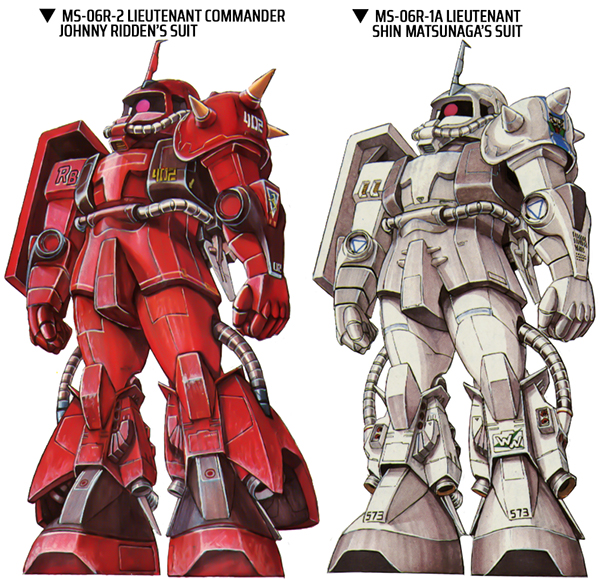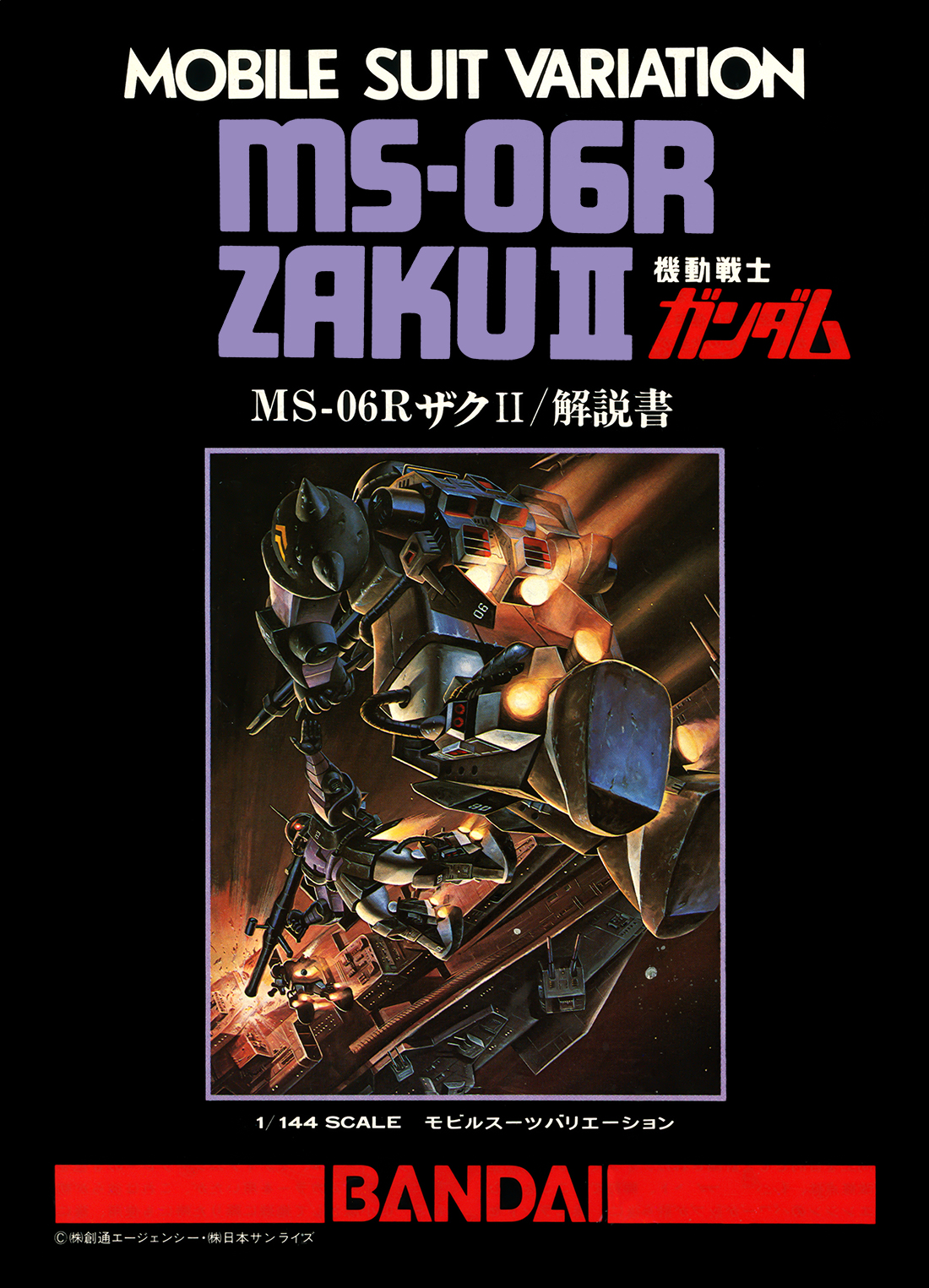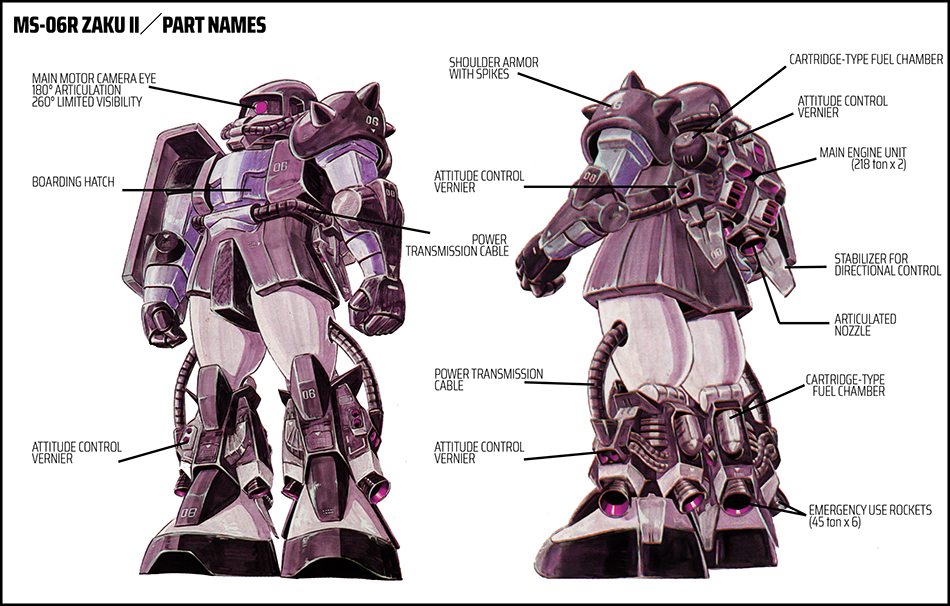Mobile Suit Variation No.1

GUNPLA INFORMATION
Scale: 1/144 Mobile Suit Variation No.1
Released: 1983.04
Price: 525 yen
JAN Code: 4902425013039
Exposition: Stream Base’s Masahiro Oda
![]()
[MS-06R Zaku II Exposition] Among the various types of mobile suits derived from the MS-06, the first mass-produced mobile suit of the Zeon forces, the R-Type is a unit that has undergone extensive power upgrades. It surpasses the standard type by far, equipped with two rocket engines with a combined thrust of 218 tons, as well as three rocket engines on each leg. However, its exceptional mobility made it an extremely challenging machine for ordinary mobile suit pilots to handle. The most famous example of achieving remarkable combat results using the R-Type is the Black Tri-Stars, who employed a devastating tactic known as the Jet Stream Attack.
![]()
MS-06 ZAKU II VARIATIONS
The MS-06 Zaku II is the foundation for all mobile suits, and it’s from this base that all Zaku variations emerge. Initially, the Zaku utilized in space combat was designated as types A and C; however, only a handful of type A were manufactured, and the production line was subsequently dedicated to type C. Although there were no notable external differences, the cockpit hatch systems varied. The ensuing type F saw improvements in the cockpit design and alterations in payload capacity based on pilot feedback.
The tradition of providing exceptional pilots with superior equipment is as old as warfare itself, and the Zaku line was no exception. High mobility models were created in response to certain demands, such as the S type, which featured a 30% increase in engine thrust. It is said that over a hundred of these units, intended for commanders, were manufactured. Further performance enhancements aimed at the Zaku itself led to the development of the R type, which doubled engine thrust and added acceleration boosters. Due to cost constraints and falling pilot proficiency, only a few of these units were produced, and they were restricted to experienced pilots. Variations, such as the R-09 type with increased fuel capacity and the R-2 type that competed for selection, also existed. During the early to middle stages, the E type was produced for forced reconnaissance missions (which involved extensive modifications to the mono-eye and lightweight design, with detection systems installed throughout), and a few T types were manufactured as trainers.
In ground warfare, the J type, a streamlined version of the F type where unnecessary systems were removed for weight reduction, primarily saw action. From this base model, a myriad of experimental machines were born. High-demand models for the tropics in Africa and Asia led to the production of the tropical warfare D type. The K (J-12) type was designed for anti-aircraft defense and medium-range support, the M type was a hydro-jet engine test model, and the G type was created for enhanced mobility.
The Zaku was employed as a research base for various projects, but perhaps the most peculiar was the Z type, which was equipped with a psycommu system. It was used as a test base for the MSN-02, and because it was directly equipped with the beam cannons intended for use on the MSN-02, it had disproportionately oversized arms.

ABOUT THE MS-06R TYPE
The MS-06R was a planned iteration aimed at improving upon the performance of the mainstream F-type. Key prototype improvements were centered around the back, waist skirt, and leg sections, where the engine’s power was upgraded. Particularly noteworthy is the addition of two units of thrust verniers on the backpack, which far exceed the normal type. Unit 1 and Unit 2 were painted bright orange-yellow for testing, and various trials were conducted at the Granada base. Lieutenant Commander Elliot Rem, a test pilot since the inception of the Zaku project, was invited for these tests. Rem personally piloted Unit 1, repeating tests over two weeks. The performance was outstanding, leading to an immediate decision to mass-produce. Twenty-two units were ordered as the initial production run, given the designation of the R type.
Rolled-out units were dispatched to various fronts for field testing. However, the loss of many excellent pilots from the MS-05 forces during initial operations still had a profound impact. A slew of pilots were unable to fully master the R-type, developed as a high-mobility type. This could be said for the F-type too. Pilots were prone to quickly exhaust the limited onboard rocket fuel, which could be deemed unfortunate for the Zaku, which needed more skilled pilots.
The MS-06R can be broadly classified into three types. The original fuel could be resupplied via the mothership Musai or Valkyrie-type carriers. Still, repeated reports from the battlefield resulted in the backpack and leg fuel tanks being simplified into cartridge-based systems. Units before the modification, up to twenty-two in total (of which about 10 were later converted to the same specification), are referred to as R-1, while the later cartridge types are distinguished as R-1A. Each squadron that operates alongside the Musai, primarily or entirely made up of R-type, was accompanied by a single Zaku assigned for resupply.
The suit itself exhibited high performance when handled by skilled pilots, but the conditions required to operate the R-type became complex. Due to a lack of cost-effectiveness and simplicity, production was subsequently halted. However, it was well-received by ace pilots, and there were inquiries from various sectors for the few remaining units in the production line. These remaining units were handed out on an order-adjustment basis.
Usage examples of the R-type are mostly flashy and famous, thanks in part to them being assigned to the aces. Among them are those who reported directly to Admiral Kycilia. Most notable is likely the Black Tri-Stars, led by Ensign A. Gaia (later promoted to Lieutenant, but was KIA). After they started working as a team, they sequentially operated MS-05B, MS-06C, S, and R. Starting from the S-type, they used team colors based on black, purple, and medium sea gray. This was also used when they descended to Earth as the first MS-09 squad and later adopted as the official color scheme for the MS-09.
Lieutenant Shin Matsunaga of the Solomon Front is among the aces piloting the R-1A, following the Tri-Stars in fame. At the young age of 26, he has sunk five Salamis, and Magellan ships single-handedly since the outbreak of the war. He served as the personal guard for Vice Admiral Dozle during his battlefield inspection (in reality, he participated in combat) and is a renowned warrior. He painted his suit in white and gray, earning him the feared nickname “White Wolf.”
The third type of MS-06R is the MS-06R-2, which competed with the MS-R09 for selection as the successor to the MS-06. It increased the fuel load capacity by 18%, strengthened the leg armor, and changed the cockpit to direct-in, among various other modifications. Four units were produced, but they were a step behind the MS-R09 in overall performance, despite some superior individual capabilities. This R-2 type was also circulated among the aces after some time, and Lieutenant Commander Johnny Ridden’s crimson suit, painted in a striking combination of red and black, is notable. Post-war photo collections often mistakenly present it as the “Red Comet” R-type, but it’s actually Ridden’s mobile suit.
![]()






